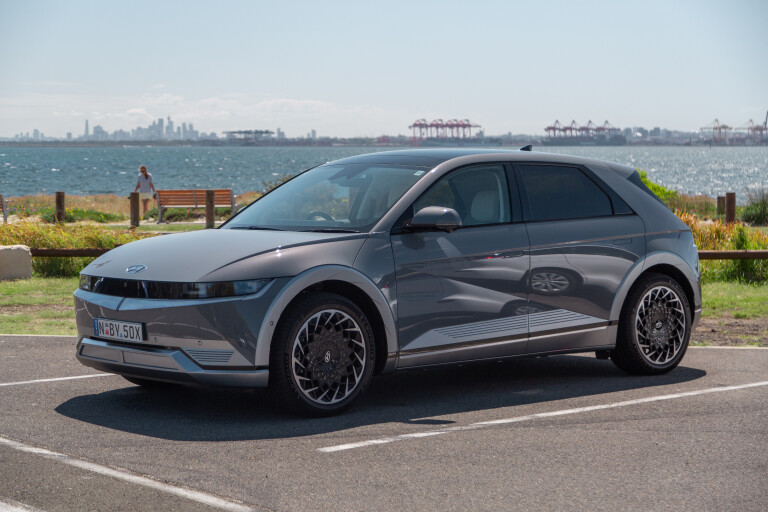
Key Points
- 58kWh and 72.6kWh battery sizes
- 470-480km driving range in RWD, 72.6kWh form
- Starting price of $71,900 before on-road costs
UPDATE, January 20, 2022: Vic, QLD and WA buyers set for second allocation to open
A second release of the 2022 Hyundai Ioniq 5 is set to become available for buyers in Victoria, Queensland, and Western Australia from Thursday, January 27.
Following on from NSW and ACT customers getting their shot in December, the ordering platform will be opened up for buyers from other states, with all cars expected to arrive in the first half of the year.
Read the full story below.
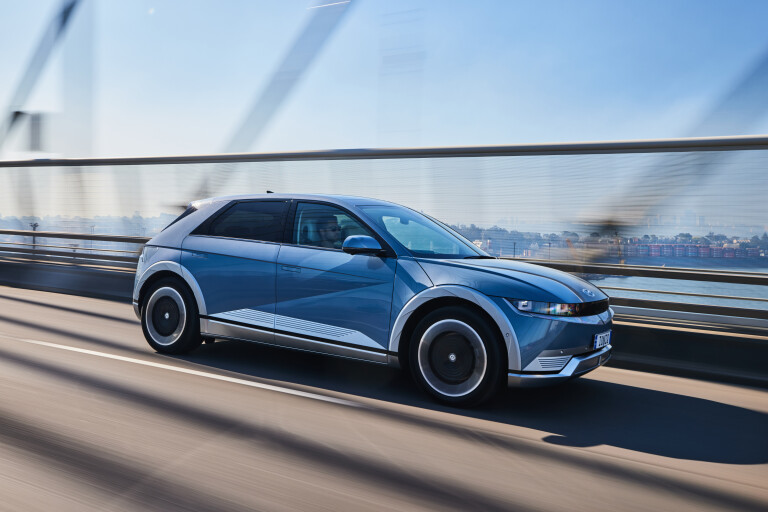
December 16, 2021: Second allocation opens to ACT and NSW buyers
The second allocation of Hyundai's Ioniq 5 has opened to buyers from the ACT and NSW, as the expected demand nationwide would potentially cause another website crash.
Hyundai has been quick to clarify buyers from other states and territories won't receive their cars later than those in the ACT and NSW, with the second allocation all set to launch around the same time in the first half of 2022.
Read more in the report below.
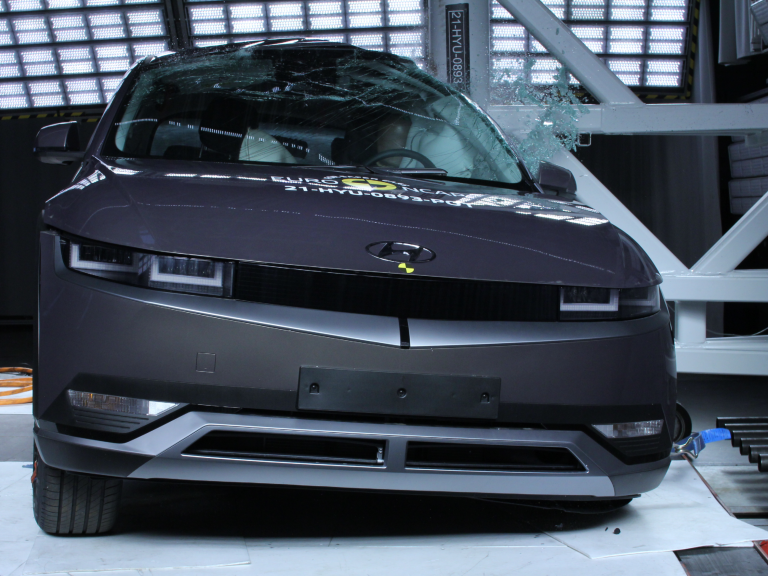
October 27, 2021: ANCAP awards Ioniq 5 five-star safety rating
Ahead of going on sale in Australia, the Ioniq 5 has scored flying colours in an important test, taking five stars from ANCAP.
Scoring particularly well in the adult and child occupant protection tests, the Ioniq 5 solidified itself as one of the safest EVs on Australian roads.
Read more about the Ioniq 5's safety here.
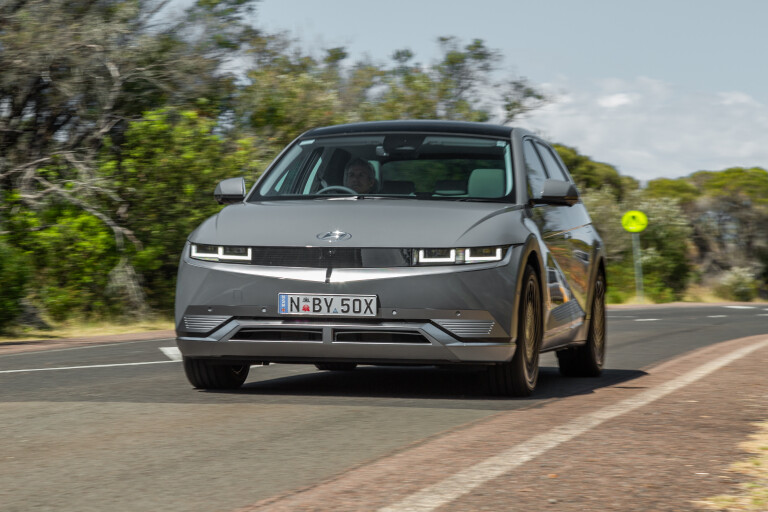
October 22, 2021: Jez Spinks takes Ioniq 5 for its first Australian drive
The first examples of the Hyundai Ioniq 5 have arrived in Australia, and our man Jez Spinks has sampled the in-demand EV for the first time.
Want to know what he thinks of Hyundai's new flagship on Australian roads? Read below to find out.
October 12, 2021: First Ioniq 5 allocation sells out within two hours
Demand for the Ioniq 5 has resulted in the incoming electric vehicle selling out within two hours, as buyers snapped up the first 240 examples.
The rush of customers for the Ioniq 5 caused the ordering site to crash, with Hyundai resuming service later on in the day before the 240 built slots had disappeared.
Hyundai expects all cars sold would arrive before 2022, with an extra allocation to be released early next year.
Read the full report below.

September 20, 2021: Australian pricing and features revealed
After months of waiting and speculation, Hyundai has set a price for its Ioniq 5, starting at $71,900 for the rear-wheel drive variant while the dual-motor sets buyers back another $4000, going on sale from $75,900 before on-road costs.
Buyers will have the option to choose either a single electric motor sending 160kW/350Nm to the rear wheels, or a dual-motor version with 225kW/605Nm and all-wheel drive.
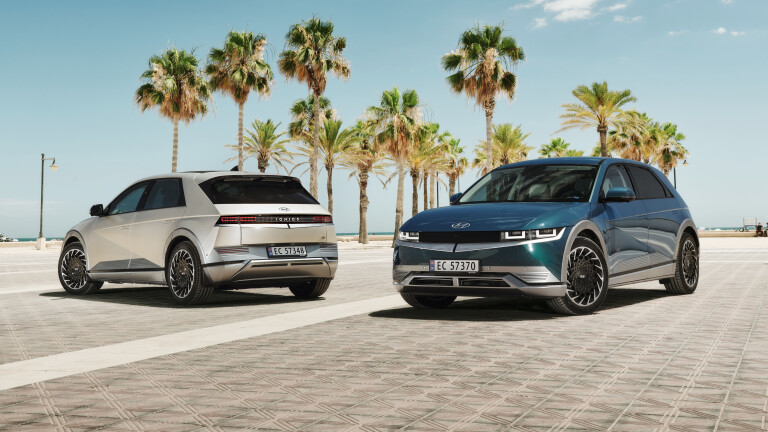
April 21, 2021: Early walk-around videos emerge
As the Australian launch of the Ioniq 5 draws closer, a number of walk-around videos have been published.
This week, however, a video has surfaced out of Korea showing the Ioniq 5 alongside Tesla's Model 3 – a car the Ioniq 5 is likely to be priced below, but not by much.
If you skip ahead to 04:25, you'll see the angular Ioniq 5 is markedly larger than the Model 3, despite its hatch-like, Pony-inspired styling.
Catch the rest of our expansive Ioniq 5 coverage below, and be sure to watch our video at the top of this story.
April 3, 2021: WhichCar video tour
This week, WhichCar was given the opportunity to go hands-on with the 2022 Hyundai Ioniq 5 in Sydney.
Watch our video above to see our tour of Hyundai's new electric family car, and catch our earlier coverage in the story below.

February 23, 2021: Hyundai Ioniq 5 revealed
It’s a rare event when a new model is unveiled with styling so loyal to the show-car concept that came before it. In the Ioniq 5 revealed today, Hyundai has managed just that.
The 2022 Hyundai Ioniq 5 follows the 2019 debut of a ‘modern retro’ concept known as the 45 – a tribute to the Giorgetto Giugiaro-penned 1974 Pony Coupe Concept that loosely previewed the important but decidedly more pedestrian 1975 Pony hatch.
The Ioniq 5 brings the same boxy and angular lines that were common to most models in the Pony’s day, while adding bold character lines and details for futuristic flair.
Importantly, the Ioniq 5 stands apart from the Hyundai brand’s familiar styling at the front and rear, although the sharply geometric lines through the doors share a theme with the new Tucson and i30 Sedan (née Elantra) models.
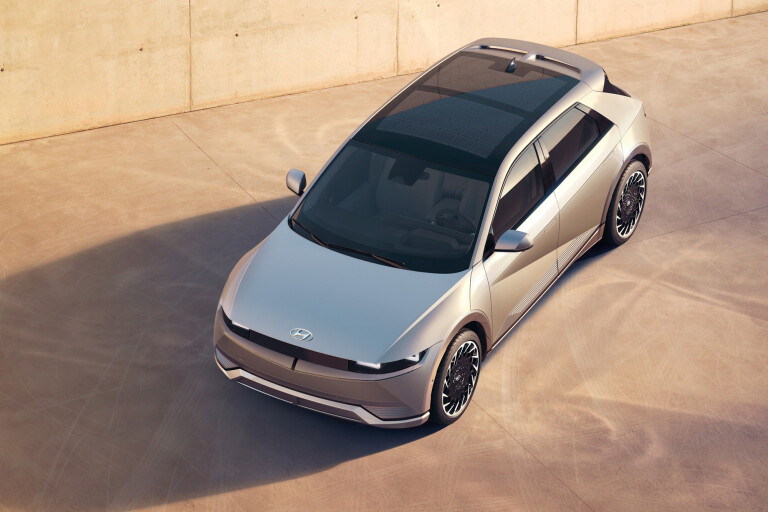
Electric drive: Ioniq 5 performance, range and charging
Built on Hyundai’s new EV-focused E-GMP architecture, the Ioniq 5 will be offered with three battery and motor configurations – although it is unclear for now if we’ll see each in the Australian line-up.
At the top of the range is an all-wheel-drive (AWD) setup with an electric motor at each end of the car, producing a combined 225kW and 605Nm.
An entry-level rear-wheel-drive model will also be offered with just one motor (350Nm torque, power figure unannounced).
Both can be had with either a 72.6kWh or 58kWh battery pack.
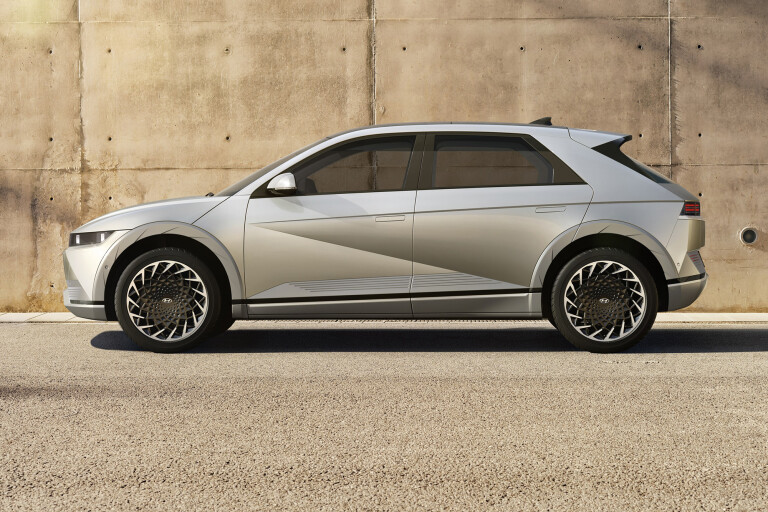
Hyundai claims the 72.6kWh AWD model will sprint to 100km/h in a hot 5.2 seconds, while the 58kWh AWD model is limited to a perfectly adequate 6.1-second time.
Opting for the 72.6kWh RWD model will deliver a claimed 7.4-second 0-100km/h time, with the 58kWh RWD model listing an 8.5-second run.
The 72.6kWh RWD model lists a WLTP-tested driving range of “around” 470 to 480 kilometres.
Driving range for the other configurations is still to be revealed.
The Ioniq 5 will support both 400V and 800V charging infrastructures as standard without the need for adapters – a feat which Hyundai is declaring a patented world-first system, thanks to its ability to run the motor and inverter to boost 400V to 800V for stable charging.
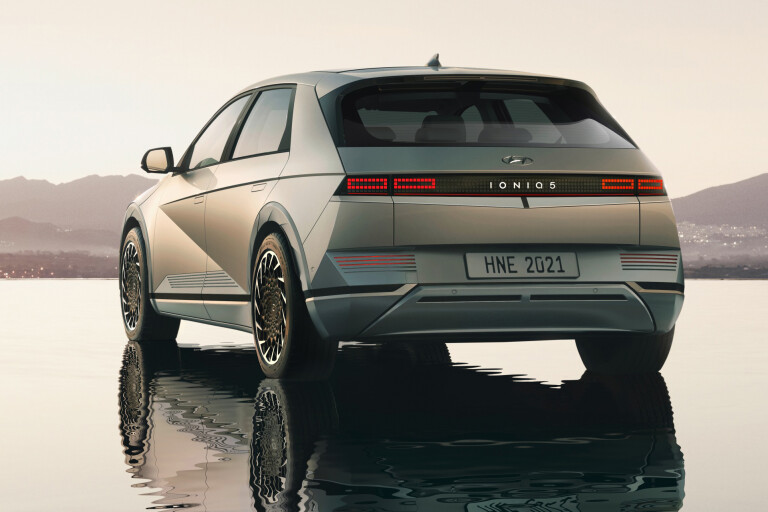
Hyundai claims a 350kW fast charger will bump the Ioniq from 10 per cent to 80 per cent charge in 18 minutes, and a full 100 kilometres of driving range will be available after five minutes of 350kW charging.
Charging times for slower systems are still to be revealed.
In Vehicle-to-Load mode, the Ioniq 5 can supply up to 3.6kW of power, allowing it to charge electric devices like personal transportation gear, camping equipment or power tools.
Feeling generous? That power output will also let you lend some charge to something like a Nissan Leaf, if you've got the hours to spare – its 40kWh battery pack leaving you some to spare. In a pinch, you'll give the Leaf around 15km of driving off one hour of loaned charging.
A neat feature of the Ioniq 5 is the availability of a solar roof, allowing the vehicle’s power system to feed energy back into its battery pack.
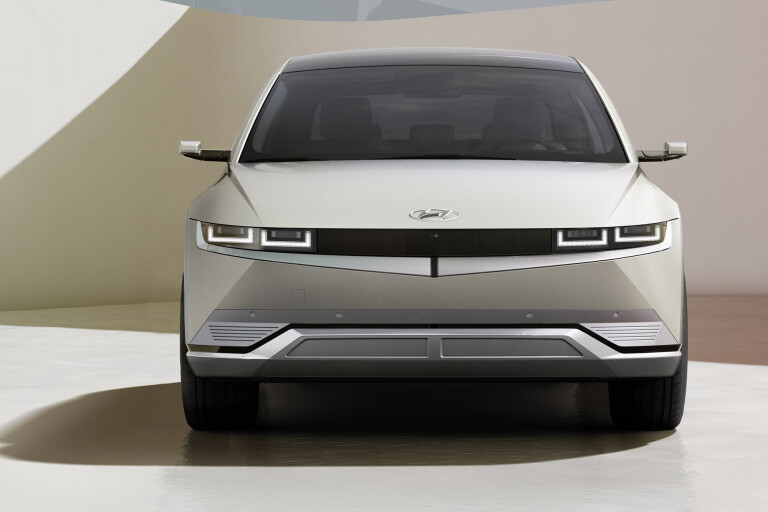
Design and dimensions
The angular 45 concept was anything but dull, and to its credit, Hyundai has bravely retained its essence and key design details in developing the final production car.
The Ioniq 5 is the first offering in a new line-up of electric vehicles, with an Ioniq 6 electric sedan and Ioniq 7 electric large SUV to follow in the coming years.
In that range, the Ioniq 5 is well-positioned as the first to launch, thanks to a design perfectly suited to one of the world’s strongest-selling market segments – the midsize SUV.
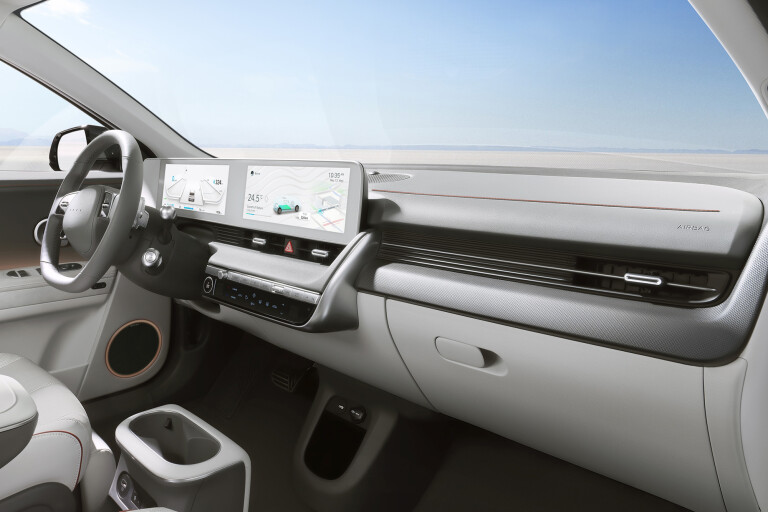
Despite its compact looks, the Ioniq 5 rides on a 3000mm wheelbase, which outdoes the huge Palisade SUV’s 2900mm footprint.
It’s a configuration made possible by its electric architecture, allowing the wheels to be positioned far into each corner of the car, with very short overhangs. All of this should make for a spacious cabin.
Overall, the Ioniq 5 measures 4635mm long and 1890mm wide, making it more of a match for the new long-wheelbase Tucson we’ll get in Australia, which measures 4670mm long and 1895mm wide. Its wheelbase is much shorter than in the Ioniq 5, however, at 2755mm.
The Ioniq 5’s proportionally wider design is further emphasised by its shorter height, coming in at 1605mm tall – compared to 1665mm for the new Tucson.

Seats-up cargo space in the rear of the Ioniq 5 is listed at 531 litres, growing to 1591 litres with the 6:4-split second row folded to the floor. The second-row seats can also slide forward for additional cargo space.
Hyundai’s newest EV also boasts a feature many new EVs still lack: a front storage space, known colloquially as a ‘frunk’ (although ‘froot’ might be more appropriate in Australia). This space offers an additional 57 litres of storage capacity in RWD models, while the presence of a front motor in the AWD model drops its capacity to 24 litres.
If even more carrying space is required, the Ioniq 5 lists a towing braked towing capacity of “up to” 1600kg – a number which will likely vary depending on the model selected.
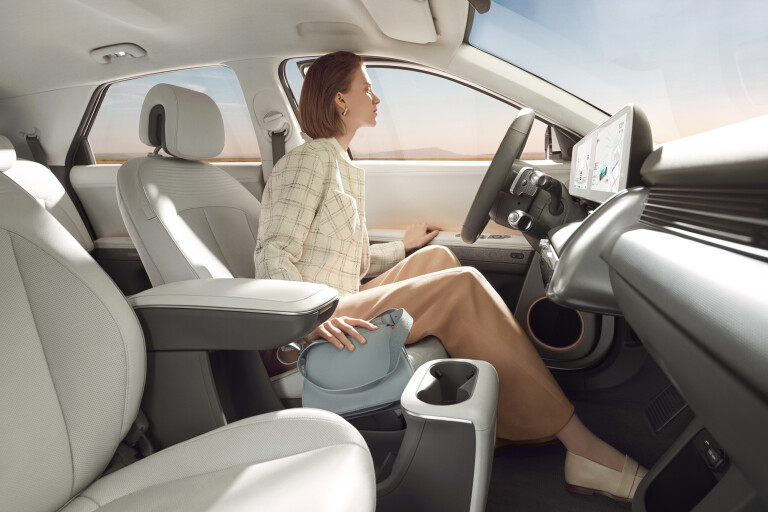
Interior features and technology
All of this culminates in what Hyundai has termed a ‘Living Space’ interior theme, with a movable centre console and a long slide for the front seats to enable a resting position akin to the business-class comfort offered in airliners – assuming there are no passengers in the second row.
The Ioniq 5’s dash is dominated by two 12.0-inch displays, butted together to form a single unit that shows driver details on one and shared infotainment features on the other.
Infotainment is properly new in the Ioniq 5, too, launching a design theme called ‘Jong-e’ with a new look and new features such as interior ambience settings.
This is joined by an Augmented Reality Head-Up Display (AR HUD). Images and footage of this system are still to be released, but Hyundai says drivers will be able to project relevant information “to their line of sight across the windshield”. This wording suggests all or large sections of the windscreen will be able to display information, although it is unclear how this would be enabled in production form.

Hyundai’s Bluelink connectivity system features in its latest form, offering mobile phone access to details like driving range, battery state and charging times when plugged in, along with remote control over various vehicle settings.
The vehicle can also be started remotely to allow for pre-conditioning of interior temperature and preferred driver settings. Likewise, if the vehicle is left unattended with its doors unlocked or windows open, the driver can be alerted automatically.
The Korean car maker is also trumpeting its sustainability efforts here, with interior items like the seats, headliner, door trim, floor and armrests all made with PET bottles, plant-based yarns and natural wool yarns, along with “eco-processed leather with plant-based extracts and bio paint with plant extracts”. Details on any sustainability-focused measures taken in the Ioniq 5’s production, however, have not been offered.
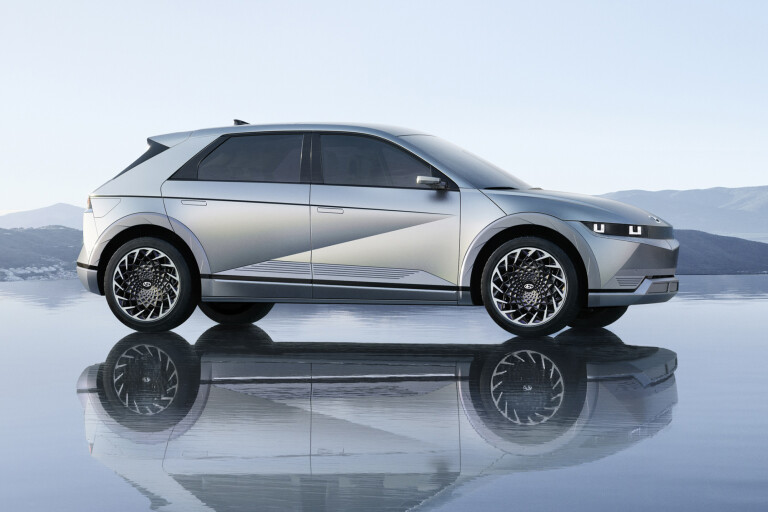
Safety
Other driver assistance safety systems include the Highway Driving Assist 2 (HDA 2) suite. Using a front-view camera, radar sensors, and navigation data, HDA 2 works to control the vehicle speed and following distance, while keeping the vehicle centred in its lane. It can also assist the driver when changing a lane.
There’s also Forward Collision-Avoidance Assist with Junction Turning, Junction Crossing and Lane-Changing Oncoming – each designed to detect advancing traffic that could unexpectedly move into the Ioniq 5’s path. This is matched to Blindspot Collision Avoidance and Blindspot View Monitor, the latter using cameras to show the driver a view of the vehicle’s left and right as needed.
Intelligent Speed Limit Assist is featured, along with High Beam Assist.
The list goes on, with Driver Attention Warning – featuring a display of the driver’s measured attention, with warning indicators if inattentiveness is detected.
Finally, there is also Safe Exit Assist for the second row that monitors oncoming traffic, Remote Smart Parking Assist that allows parking to be controlled from outside the car, Reverse Parking Collision Avoidance, Rear Cross-Traffic Collision Avoidance, and Surround View Monitor for a 360-degree vehicle view from the dash.

When is the Ioniq 5 coming to Australia, and what will it cost?
The 2022 Hyundai Ioniq 5 is confirmed to launch in Australia sometime in the third quarter of 2021.
Australian models and pricing is still to be detailed, although the local division has confirmed we will get both rear- and all-wheel-drive versions. Still to be locked in is whether we’ll get both battery packs, and in which drive configuration.
A starting price for the Ioniq 5 is difficult to speculate on, with the more compact Kona Electric already starting at just over $60,000.
We could see the Ioniq 5 come in at a suitably higher price point, or the Kona Electric’s price could be dropped – or a little of both might occur.
Could Australian buyers stomach a $70,000-plus electric Hyundai that improves on the Kona Electric’s already impressive driving range and performance while rivalling the midsize Tucson and giant Palisade in dimensions and interior space?
Hyundai also has a more affordable Kona Electric model available overseas, which offers a smaller 39kWh battery pack instead of the 64kWh system that offers 450km of driving range in the current Australian-delivered model.
If that 39kWh model were to become available to the Australian division, it could conceivably drop the larger-capacity model and cut the Kona Electric’s price in the process.
Of course, with the Kona Electric having hit the stage in early 2018, it could feasibly be retired in the near future – at least in Australia, leaving the Ioniq 5 to take over its price point with a more compelling package.
Whatever the case, we’ll be able to stop speculating sometime in the months ahead when local Ioniq 5 details are revealed.
What do you think about the Ioniq 5? Tell us in the comments below!

COMMENTS